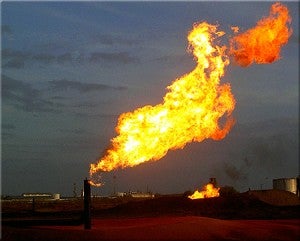 When the White House confirmed plans to limit methane pollution from the oil and gas sector — not just from new or heavily modified facilities, but thousands of existing wells, pipelines and other facilities that are currently emitting at least 9.3 million metric tons of the invisible heat-trapping gas each year — industry responded with the usual complaints about back-breaking costs.
When the White House confirmed plans to limit methane pollution from the oil and gas sector — not just from new or heavily modified facilities, but thousands of existing wells, pipelines and other facilities that are currently emitting at least 9.3 million metric tons of the invisible heat-trapping gas each year — industry responded with the usual complaints about back-breaking costs.
Unlike recent years, those objections come with a twist: The widespread (and very real) challenges in an oil and gas sector struggling with a global supply glut and sharply lower prices, both enabled by the same unconventional production technologies that fueled the boom in the first place. We simply shouldn’t impose new regulations in a down market, the industry says.
To be clear: There’s no disputing these are tough times for oil and gas. Hard working Americans have lost good jobs by the tens of thousands. Communities are suffering. It’s a cycle familiar to anyone who’s been around the industry, even if that doesn’t make it any easier on people living through it now.
However real they may be, however, these market conditions aren’t a good reason for cutting corners on emissions. The underlying problem – air and climate pollution – remains costly and dangerous, regardless of the day’s NYMEX numbers. We also know that prices won’t stay low forever; indeed, there are already beginning signs of a rebound.
And don’t forget that industry also opposed methane emissions standards when prices were high, too.
No matter where we are in the boom-and-bust cycle that has characterized the industry since its inception, the oil and gas sector remains the largest industrial source of methane emissions in the U.S. And reducing these emissions is still the biggest, most cost-effective opportunity we have to make fast, meaningful reductions in greenhouse gas pollution.
Bang for the Buck
The math is pretty simple. Methane packs 84 times the warming power of carbon dioxide for the first 20 years it is in the atmosphere. It accounts for one quarter of the human-caused warming we are currently experiencing. Moreover, methane often comes with other noxious or toxic emissions that have a big impact on neighboring communities.
Cost-effective solutions are available right now. Many are as basic as monitoring facilities regularly, and quickly fixing leaks or other malfunctions. Studies show that existing technology can cut methane leaks at least 40% at an average cost of around a penny per thousand cubic feet of gas produced – still about one-half of 1% of today’s natural gas price, even though commodity prices have fallen since the initial study.
And this isn’t just for big companies. An analysis by the Bureau of Land Management looking at the potential effects of rules to reduce emissions from new and existing methane sources pollution on small producers found that on average, compliance costs would reduce profit margins of small operators by an average of one-tenth of one percent.
Industry Itself Underscores the Point
The oil and gas industry’s own contradictory arguments against methane regulations underscore the point. At the same time they argue that it’s too burdensome to reduce emissions, they also say they’re already diligently addressing the problem, and that solving it is so simple they can do it on a purely voluntary basis. (We agree the solutions are straightforward and sensible, but don’t believe a voluntary path gets the results we need.)
The handful of leading companies that have taken steps to reduce methane know just how successful methane reduction efforts can be. Since implementing reduction technologies, operator Jonah Energy has reduced fugitive emissions by 75% and cut repair time by 85%, ultimately saving more than $5 million in what otherwise would have been wasted product.
Urgent Need, Powerful Payoff
Let’s not forget why all this matters. Last month set the new mark not only for hottest February on record, but also for the biggest margin over an old record. In other words, the warming train is gathering steam. That’s a very big deal, and its evidence of why it’s so important that we start reducing powerful, fast-acting pollutants like methane, even as the long term efforts to reduce carbon dioxide continue.
At global scale, stopping 45% of methane leakage would help the climate over the next 20 years as much as shutting down one-third of the world’s coal-fired power plants. So don’t let anybody minimize this opportunity as a trivial matter.
Methane is both a local and national problem, requiring robust detection and repair of leaks. Achieving this it isn’t hard or costly, but it does require commitment from both the state and federal levels. The Obama administration should use its final year to make sure we get it right.
Image Source: Flickr User Tod Baker









